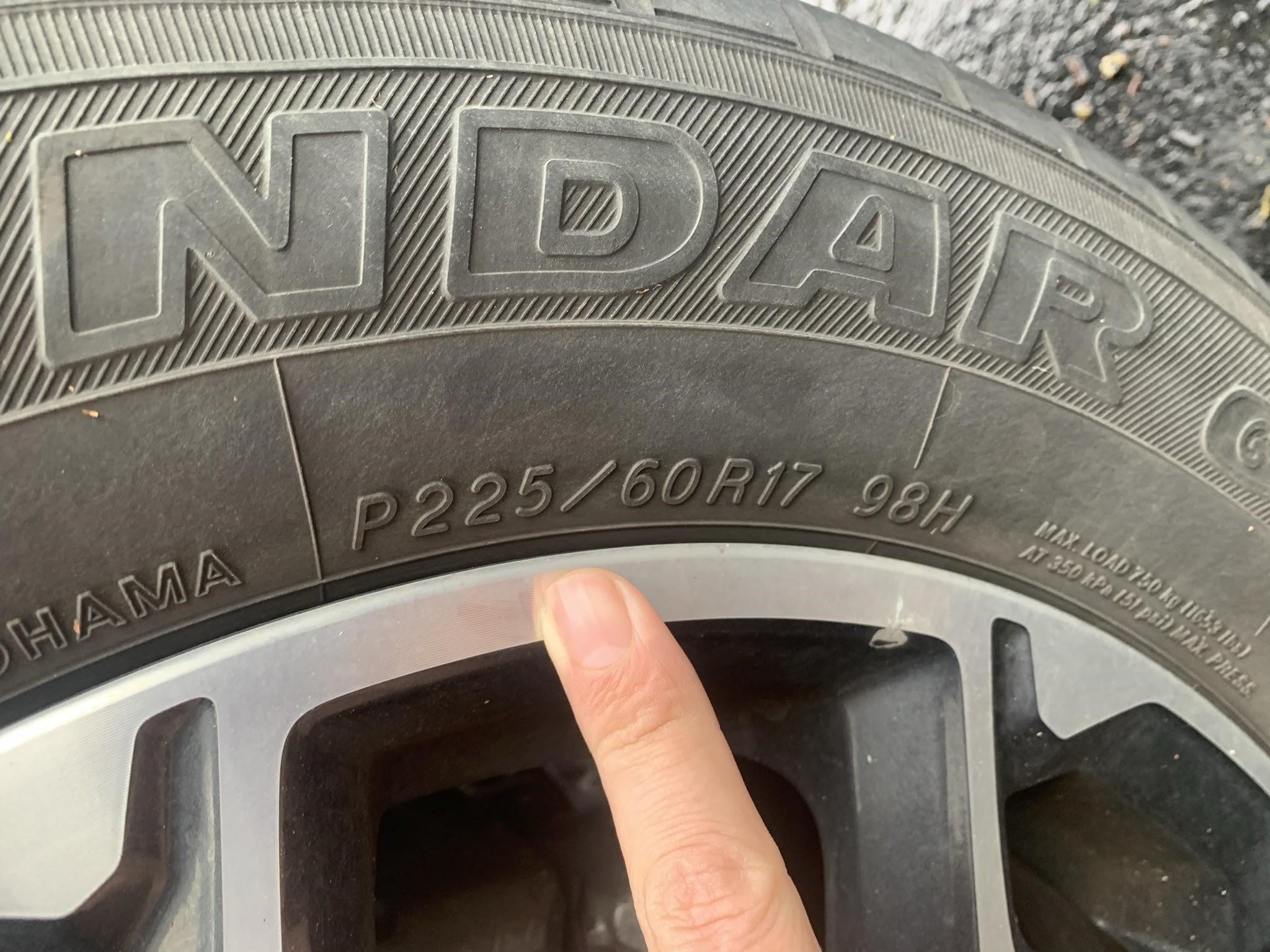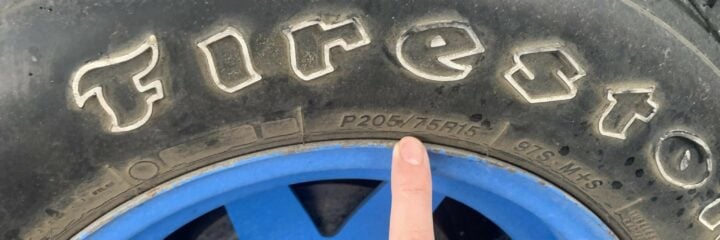There is a lot of information stamped on the side of a tire. In this series, we are going to help you decode all that information.
You can see the information stamped on the side of the tire in the picture above. The size is P205/75R15. Following that is the service description of 97S. Finally, there is an M+S for Mud and Snow as the type of tire.
This time, we’ll talk about the size. The size is expressed primarily by 3 numbers, which follow the general type of tire.
The first number is the width in milimeters, followed by a slash. The second number is the aspect ratio followed by the construction type. The final number is the internal diameter in inches.
It’s a complicated standard, so we’ll break down each section further.
Vehicle Class
We talk more in depth about this subject in a different article here, but the first letter of the rating represents the general type or class of vehicle they are meant to be used on.
There are 4 basic types: P for passenger, LT for light truck, ST for trailer, and T for temporary. Our example above is of a passenger tire, so the code starts with P.
A tire with no letter before the size indicates that it either isn’t rated or it is rated with a different standard. The ETRTO, for instance, rates tires differently than the TRA we are used to in the USA.
Width
Following the type is the width expressed in millimeters. This is the most straightforward measurement.
In our example of a 205/75R15, if you measured sidewall to sidewall, the width would be 205mm.
Aspect Ratio
Aspect ratio is perhaps the most confusing part of understanding tire sizes. The aspect ratio is the ratio of sidewall height to total width expressed as a percentage.
In our example of a tire that is 205/75, the distance from the tread to the rim is 75% of the distance from sidewall to sidewall. Put another way, the height of the sidewall is 153.75mm.
What can make this very confusing is that a tire that is very wide can have the same aspect ratio as a tire that is very narrow, and the two tires will be different diameters. A tire that is 255/75R15 will have a total diameter of 28.86in. A tire that is 205/75R15 will have a diameter of 27.1in.
Calculating the Total Diameter
The easiest way to find out what the total diameter of a tire is is to simply look up the specifications for the tire. However, it is possible to calculate it. Let’s use the same 205/75R15 tire we have been referring to.
First, you’ll have to calculate the sidewall height. The width is 205, and the aspect ratio is 75, so that means the sidewall height is 75% of 205.
205×0.75=153.75
Now we need to convert that into inches.
153.75×0.03937=6.05
Since tires are round, when they are sitting on the rim they add their sidewall height to the total diameter twice.
6×2=12
Then we simply add the internal or wheel diameter, which is 15 inches.
12+15=27
Altogether: (((205×0.75)x0.03937)x2)+15=27
If we check the specification sheet online, we will see that the tire is listed as having a 27.1in total diameter. That tenth of an inch can be accounted for as a simple rounding error during the conversion from milimeters to inches.
Low Profile
A tire with a low profile has a very low aspect ratio. Generally, a tire with an aspect ratio of lower than 50 will be considered low profile, although very narrow tires may still be low profile with higher ratios.
Most people elect to install low profile tires to maintain the same overall tire diameter after installing larger diameter wheels. It is also common for people to install “low-pros” simply because they enjoy the look.
Car Advice has an in-depth article comparing the pros and cons of going with a low aspect ratio.
Construction
After the aspect ratio is a letter that represents the construction of the tire. Most vehicles on the road use radial tires, so R is the most common label. ZR is a common alternative; the Z is simply there to say that the tire is a high-performance tire.
Other construction types are as follows:
- B for bias, common on large trucks and some trailers
- D for diagonal, which is a type of bias
- No letter for cross-ply, which can still be found on heavy equipment
Wheel Diameter
The final number describes the diameter of the wheel, in inches, that the tire is meant to fit.
The only frustrating part about deciphering this number is that we started in metric and ending in standard. Even in parts of the world that primarily use metric, it is common for the wheel diameter to be expressed in inches.
Alternative Descriptors
Often when talking about tires, especially truck and offroad tires, people may simply use the total diameter of the tire in inches to describe it instead of the aspect ratio. For instance, a common off road 285/75R16 tire, which is common for offroad vehicles, will simply be called a “33” because the total diameter is close to 33in (32.8).
It’s not uncommon to hear the width expressed in inches when talking about these tires as well, e.g., a 33×11 on 15s would be a tire that is 33in in diameter, 11in wide, and on a 15in rim.
Buying the Correct Size

Most people can simply use the manufacturer’s recommended size. However, if you are switching to a different type of tire or have aftermarket wheels, you may need to do some extra research.
The best way to know if a tire will fit is to browse forums dedicated to wheels and tires or talk with a tire fitter in person. If you want to know how the decisions are made or want to tackle the job yourself, then you’ll have to familiarize yourself with the following factors.
Wheel Diameter
The diameter of your wheel is usually the biggest limiting factor when buying a tire. Manufacturers will often only manufacture a tire line for a specific wheel size range, and the more uncommon your wheel diameter is, the fewer options you will have.
Modern vehicles tend to use 16”, 17”, and 18” wheels, but older cars would commonly have 13” or 14” wheels.
That means when looking for tires, your first step should be to find out your options for your wheel size. If you have an unusual size like 13” or 22”, it can help to search for manufacturers that specialize in making those tires.
Width
Width is a more flexible measurement than wheel diameter because tires can be stretched or pinched onto a rim. Stretching is very common in the stance and fitment world, and if you want to know more about it, there is a fantastic post on the Stanceworks forum.
Basically, a wheel that is a little wider or a little narrower than your wheel can still be installed on your wheel. Offroaders might install a wider tire for extra traction, while someone with a lowrider may stretch a narrower tire so that it doesn’t interfere with the fenders.
Clearance
The final ingredient in choosing a tire size is knowing the physical space you have for the tire. Putting a wider tire or a tire with a larger aspect ratio may cause the tire to rub on the inside of the fender. There are no shortcuts; you just have to take out your tape measure and double-check your physical clearances.
This Is Part of a Series All About Tires
Our aim is to demystify the tire buying process and help you make the best decisions possible. Feel free to continue learning by jumping over to one of the following topics:


